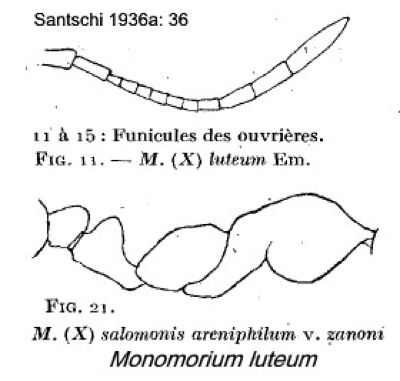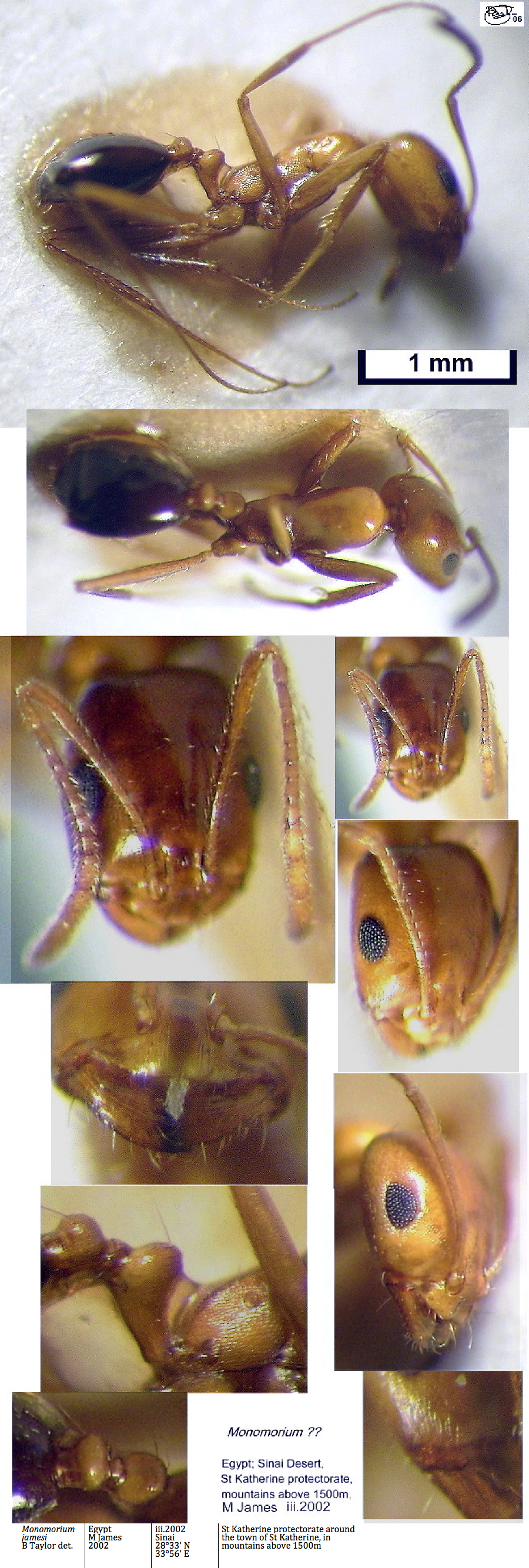Monomorium jamesi new species in barbatulum-group
 WORKER - TL ca 3.1 mm, HW 0.6, SI 125; WORKER - TL ca 3.1 mm, HW 0.6, SI 125;
Mike James noted that foraging is early morning and
evening, taking food items back to nests under plants or rocks.
Initially I thought this was Monomorium
niloticum Emery but that is noted as coastal, with HW
0.80-0.88 and SI 100. In May 2006, I received two specimens of niloticum
from Sudan, which match the original description. These
James specimens have a lower petiole profile, a shiny pronotum dorsum
and a shallow median impression on the clypeus, all clearly distinct
from niloticum.
From the key in Collingwood & Agosti (1996),
starting with terminal segment of funiculus being longer than preceding
two together, one would get to Monomorium rimae; but that is
much smaller with short antennal scapes, TL 1.8 mm, SL 0.25 (SI = HW/SL
= 70.2) [see pdf page 38 (337)]. The Monomorium analysis and
new species, etc., in Collingwood & Agosti was checked by Bolton,
who had revised the Afrotropical Monomorium in 1987 but has not
reviewed species from North Africa nor the Middle East.
|
 On
reading Santschi' s analysis of Monomorium (1936a: 36),
however, the description of Monomorium luteum
Emery (Emery,
1881b: 533, holotype worker only), type location Aden, seemed
very similar to these specimens. On
reading Santschi' s analysis of Monomorium (1936a: 36),
however, the description of Monomorium luteum
Emery (Emery,
1881b: 533, holotype worker only), type location Aden, seemed
very similar to these specimens.
Emery's (1881b) description is at  . Santschi (1936a) gave a
fuller illustrated description, apparently based on examination of the
holotype by Menozzi; this is at . Santschi (1936a) gave a
fuller illustrated description, apparently based on examination of the
holotype by Menozzi; this is at  . The size given by Emery is TL 3.4 mm,
with a slender form, the petiole ndes are subequal with the first being
higher. . The size given by Emery is TL 3.4 mm,
with a slender form, the petiole ndes are subequal with the first being
higher.
My translation of Santschi is -
"Head rectangular, a quarter longer posteriorly than the width; with
the head slightly narrower anteriorly; the occipital border straight,
the sides weakly arcuate with the posterior angles rounded. Eyes set at
the midpoint and about one quarter of the head length. Frontal carinae
weakly arcuate, parallel about a quarter longer than the space between.
Anterior border of the clypeus weakly impressed between the weakly
divergent carinae. Mandibles striated. Scape surpassing the occiput by
about a quarter of their own length. All funiculus segments longer than
wide (Fig. 11). Promesonotum slightly convex dorsally, like that of zanoni
(Fig 21) but with a wider metanotal groove. Profile of dorsum of
propodeum flat, subbordered and with a longitudinal grrove continuing
onto the declivity, that is short and with a 110° angle from the
dorsum. Petiole profile as zanoni but with a longer pedicel.
Post petiole higher than long not bigger than the petiole. Legs
elongated. Pubescence of the appendages slightly oblique; scape with
some erect hairs. Type TL 4.3 mm (?) from Ras Doumier Ah (G. Doria),
30.xii.1879". In his key, Santschi separated luteum as being
entirely yellow - this seems to be the main difference from the
specimens collected by James and Sharat. A possibility is that Emery
saw only a freshly emerged specimen in which the colours had not
darkened.
Collingwood & Agosti (1996: ) report luteum
but separate it in their key as "Larger species, TL at least 3.8, HW
more than 0.75". In their text (p 349) they have TL 4.0-4.2, HL
1.13-1.15 [given as 113-115?] HW 0.76-0.78; SL 1.10-1.13; CI 66.1 SI
1.140-1.147. The petiole node is given as low with a smoothly rounded
dorsum - quite different from the Emery or Santschi descriptions.
Collingwood (1985: 271) says little but implies he had seen specimens
in Berne and from Oman, with the body colour yellow except for the
brown apex of the gaster; he does not list Santschi (1936a) among his
references. Collingwood & Agosit list that paper but do not refer
to the luteum description.
|
Oxford University Museum
specimens
Monomorium jamesi
B Taylor det.
|
Egypt
M James
2002
|
iii.2002
Sinai
28°33' N
33°56' E
|
St Katherine
protectorate
around the town of St Katherine, in mountains above 1500m
|
1
|
 |
Monomorium jamesi
B Taylor det. |
Egypt
A Shepherd
mid striga
|
2010
Sinai
28°33' N
33°56' E
|
St Katherine
protectorate
around the town of St Katherine, in mountains above 1500m
|
2
|
 |
Monomorium jamesi
B Taylor det. |
Egypt
A Shepherd
Alcohol E
|
2010
Sinai
28°33' N
33°56' E
|
St Katherine
protectorate
around the town of St Katherine, in mountains above 1500m
|
2
|
 |
Monomorium jamesi
B Taylor det. |
Jordan
A Lenoir
150c
|
21.ii.2012
Rum Village
29°34'32.2" N
35°25'09.1" E
|
1109 m
workers
|
2
|
 |
|
 Photomontage of a worker from Egypt, Sinai, M James Photomontage of a worker from Egypt, Sinai, M James
|
 The photomontage is of specimens from Egypt, Sinai;
collector Amy Shepherd (Alcohol E). The photomontage is of specimens from Egypt, Sinai;
collector Amy Shepherd (Alcohol E).
|
 The photomontage is of specimens from Egypt, Sinai;
collector Amy Shepherd (mid Striga). The photomontage is of specimens from Egypt, Sinai;
collector Amy Shepherd (mid Striga).
|
 The photomontage is of specimens from Jordan, Wadi Rum; A Lenoir (Lenoir 150c). The photomontage is of specimens from Jordan, Wadi Rum; A Lenoir (Lenoir 150c).
|
|